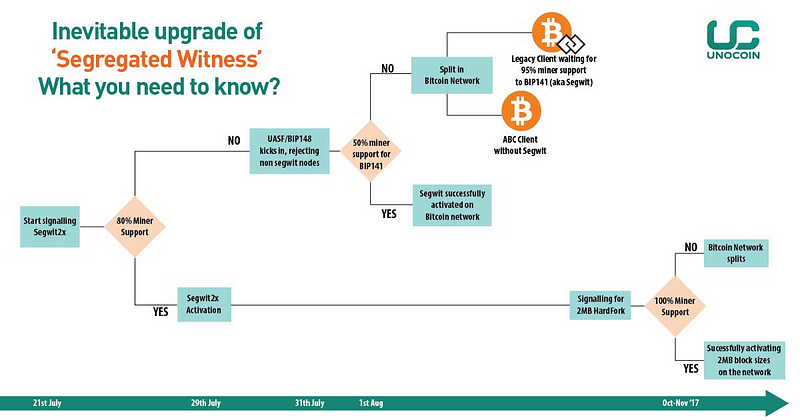
Scenario (Why do we need an upgrade?)
Growing interest in Bitcoin as a rational payment system or a safe and secure investment started to challenge the capacity of Bitcoin network about a year ago. Bitcoin’s use as a currency/payment network would soon become less viable with the current 1MB of hard limit on block sizes.
While we have seen multiple proposals/roadmaps emerge out of the never ending scaling debates for Bitcoin, there has not been a clear majority in supporting any of these propositions.
However, we are now seeing a vast majority of the Bitcoin community supporting to incorporate a new architecture of transaction blocks called “Segregated Witness” initially formulated by Dr. Peter Wuille, Bitcoin Core developer and Co-Founder of Blockstream.
Technical advantages of Segregated Witness
This section is too technical and you can skip this if you are not interested. The new architecture of Segregated Witness will provide the ability to separate ‘Witness data’ (aka Sender’s Signature data) of transactions into a block extension (new additional data structure of the transaction Merkle tree mirroring with the signature Merkle Tree) by providing a hard limit on “block weight” rather than “block size”.
With a hard limit of 4MB on the block weight [Block Weight = (tx size with witness data stripped) * 3 + (tx size)], we can potentially push for higher transaction throughput on the Bitcoin blockchain in-turn affecting the miner fees and confirmation times benefitting users.
Unpredictable Roadmap for the upgrade
It is essential to understand that the absence of a majority in specific code support to update the network poses a potential risk of network split which would result in two different tokens of bitcoin.
Two major code implementations for Segwit available right now are Segwit2x & BIP148:
- Segwit2x (Activated with the Majority of Hash power/Miner support of 80%) – is the implementation in support of enacting the long proposed Segregated Witness along with a hardcoded timeline to implement 2MB block size upgrade via hardfork as compared to the 1MB block sizes now.
- BIP148 (Activated with a Time lock on 1st August, 2017) – is a user (running full node) centric code upgrade putting an obligation on the miners to update their clients after the activation to support BIP141 (aka segwit signalling). It also has a provision of “segsignal” helping the miners to shift onto the chain with majority support for who are not able to decide upon their stance on BIP141 (aka segwit).
In the light of a miner activated hardfork (aka Segwit2x activation), a chain split is a very unlikely outcome.
While there exists a good majority of miner support for Segwit2x, there is a very tight implementation schedule planned for the activation of code, which would increase the chances of UASF kicking in. This would require a high majority of mining nodes (95%) to support BIP141 (aka segwit signalling), failing which there could be a permanent minority chain resulting in a network split altogether.
There is also a good amount of risk associated with a successful UASF (User Activated Soft Fork), as there is a possibility of transaction wipe out (of the transactions occurred on the minority chain at the time of upgradation) after minority chain merges with majority chain.
Unocoin’s contingency plan
In the midst of all the serious network upgradation roadmap, we would like to inform that Unocoin is equipped with a proper contingency plan either in the event of ‘UASF’, ‘Segwit2x upgrade’ or a ‘network split’ by supporting the chain with majority which likely is segwit enabled. However, Unocoin has not planned or equipped to support other shorter and weaker chains if they pop up.
We would be sharing a detailed maintenance schedule of our website for July 30th – 4th August to avoid any loss of customer’s coins via replay attacks and to choose the longer and safer chain to go with. We may have to extend this maintenance if the need be. User’s are always recommended to hold their coins with themselves for complete authority/choice of chain over the network split instead of holding them in their Unocoin wallets.
Recommendation for the users to safeguard the value of their coins during this upgradation:
Send your bitcoin holdings into a paper/hardware/software wallet which is in your possession and you control their private keys. You may also consider selling the bitcoin or converting them into alt coins which are comparatively safer at this point in time using Unocoin services or any other third party services you may choose if you are not technically capable of handling private keys yourselves.
References
BIP – Bitcoin Improvement Proposal
UASF – User Activated Soft Fork
BIP08 – Signalling resembling BIP09
BIP09 – Signalling using “bit 1”
BIP91 – Retrofitting BIP148 with support to Segwit2x by adopting “bit 4” signalling for activation and rejecting non “bit 1” nodes after activation
BIP141 – Bitcoin Core implementation including ‘Segregated Witness’ using BIP09 signalling (requires 95% of miner support for activation)
BIP148 – A User Activated Soft Fork which puts an obligation onto the miners to upgrade their clients after (1st August 2017). Also have a provision of “segsignal” for miners who wants to support the majority chain. (Starts rejecting the non “bit 1” blocks after activation)
BIP149 – Similar to BIP148, with a long range activation date (approx. July 2018) using BIP08 signalling protocol
Segwit2x – Also known as New York Agreement (or “Silbert Accord”), enforces Implementation of Segregated Witness along with a hardcoded consensus on upgrading the block size to 2MB in the next six months. (Requires 80% of the miner support for activation).
Bitmain’s UAHF contingency plan – User Activated Hard Fork to mine the legacy version of blockchain to avoid unseen implications of the newly created ‘segwit ready chain’



![Fundamental Analysis in Crypto [Updated Guide] A Comprehensive Guide to Asset Valuation.png](https://blog.unocoin.com/wp-content/uploads/2024/11/A-Comprehensive-Guide-to-Asset-Valuation-218x150.png)